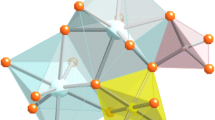Abstract
As a first step towards accurate quantification of the polysomatic states of biopyriboles, we have studied the polysomatic transformation between amphibole and hydrous triple-chain silicate (TCS) in the synthetic system Na2O-MgO-SiO2-H2O (NMSH). The reaction is: 4Na2Mg4Si6O16(OH)2 TCS ⇔ 3Na2.67Mg5.33Si8O21.33(OH)2.67. Amphibole We have characterised a polysomatic intergrowth of amphibole and TCS (synthesized at 2 kbar/(653° C) by X-ray diffraction (XRD), high-resolution transmission electron microscopy (HRTEM), infrared spectroscopy and 29Si magic-angle-spinning (MAS) NMR spectroscopy. The sample is a fine-scale lamellar intergrowth of double- and triple-chain structures; lamellae are 27 Å to hundreds of Ångströms wide. The 29Si MAS NMR spectrum of the intergrowth is explicitly a superposition of the individual amphibole and TCS spectra. By ensuring that the recycle delay time used considers the longest spin-lattice relaxation time (ca. 900 s), the relative amounts of double- and triple-chain structures can be quantified by simple deconvolution of the spectrum. The relative amounts of double- and triple-chain structures are 42 ± 5 and 58 ± 5 mol%, respectively. With regard to quantifying populations of chain multiplicities in biopyriboles, we believe that 29Si NMR is more accurate than the conventional HRTEM fringe-counting method (Maresch and Czank 1983, 1988), and is far superior to XRD and infrared spectroscopy, which suffer from high sensitivity to particle size and calibration problems. 29Si MAS NMR can provide an accurate means of monitoring the progress of polysomatic reactions in biopyriboles. It is likely to be most effective for samples containing only a few different chain multiplicities (e.g. m = 1, 2, 3 and perhaps 4), such as occur in natural pyroxenes and amphiboles.
Similar content being viewed by others
References
Biggar GM, O'Hara MJ (1969) A comparison of gel and glass starting materials for phase equilibrium studies. Mineral Mag 37:198–205
Drits VA, Goncharov YI, Aleksandrova VA, Khadzhi VE, Dmitrik AL (1974) A new type of strip silicate. Kristallografiya 19:1186–1193
Engelhardt G, Michel D (1987) High resolution solid-state NMR of silicates and zeolites. Wiley, New York
Gier TE, Cox NL, Young HS (1964) The hydrothermal synthesis of sodium amphiboles. Inorg Chem 3, N∘ 7:1001–1004
Graham CM, Maresch WV, Welch MD, Pawley AR (1989) Experimental studies on amphiboles: a review with thermodynamic perspectives. Eur J Mineral 1:535–555
Holdaway MJ, Dutrow BL, Borthwick J, Shore P, Harmon RS, Hinton RW (1986) H content of staurolite as determined by H extraction line and ion microprobe. Am Mineral 71:1135–1141
Mägi M, Lippmaa E, Samoson A, Engelhardt G, Grimmer AR (1984) Solid-state high-resolution silicon-29 chemical shifts of silicates. J Phys Chem 88:1518–1522
Maresch WV, Langer K (1976) Synthesis, lattice constants and OH-valence vibrations of an orthorhombic amphibole with excess OH in the system Li2O-MgO-SiO2-H2O. Contrib Mineral Petrol 56:27–34
Maresch WV, Czank M (1983) Problems of compositional and structural uncertainty in synthetic hydroxyl-amphiboles. Period Mineral 52:463–542
Maresch WV, Czank M (1988) Crystal chemistry, growth kinetics and phase relationships of structurally disordered (Mn, Mg) amphiboles. Fortschr Mineral 66:69–121
Maresch WV, Ruthmann W, Langer K (1990) A third possible site for hydrogen in chain silicates? Terra Abstracts 2, Abstract 87
Rocha J, Klinowski J (1991) Kaolinite as a convenient standard for setting the Hartmann-Hahn Match for 29Si CP/MAS NMR of silicates. J Magn Reson 90:567–568
Rowbotham G, Farmer VC (1973) The effect of “A” site occupancy upon the hydroxyl stretching frequency in clinoamphiboles. Contrib Mineral Petrol 38:147–149
Tateyama H, Shimoda S, Sudo T (1978) Synthesis and crystal structure of a triple-chain silicate Na2Mg4Si6O16(OH)2. Contrib Mineral Petrol 66:149–156
Thompson JB Jr (1978) Biopyriboles and polysomatic series. Am Mineral 63:239–249
Thompson JB Jr (1982) Composition space: an algebraic and geometric approach. Min Soc Am Rev Mineral 10:1–31
Veblen DR, Burnham CW (1978a) New biopyriboles from Chester, Vermont: I Descriptive mineralogy. Am Mineral 63:1000–1009
Veblen DR, Burnham CW (1978b) New biopyriboles from Chester, Vermont: II The crystal chemistry of jimthompsonite, clinojimthompsonite and chesterite, and the amphibole-mica reaction. Am Mineral 63:1053–1073
Veblen DR, Buseck PR (1977) Asbestiform chain silicates: new minerals and structural groups. Science 198:359–365
Veblen DR, Buseck PR (1979) Chain width order and disorder in biopyriboles. Am Mineral 64:687–700
Welch MD (1987) Experimental studies of selected amphiboles in the system Na2O-CaO-MgO-Al2O3-SiO2-SiF4-H2O and its subsystems. Unpublished Ph.D. thesis, Edinburgh University
Welch MD, Graham CM (1988) Proton-bearing coupled substitutions in richteritic amphiboles: a study in the system Na2O-MgO-SiO2-H2O (NMSM). Terra Cogn 8:81 (abstract)
Witte P (1975) Synthese and Stabilitat von Amphibolphasen und wasserfreien Na-Mg-Silikaten im System Na2O-MgO-SiO2-H2O, die Kompatibilitatbezeichnungen innerhalb des Sireichen Teils des quaternaren Systems oberhalb 600° C im Druckbereich l atm-5 kb P(H2O) und ihre petrologische Bedeutung. Doctoral dissertation, Ruhr Universität Bochum, Bochum, Germany
Witte P, Langer K, Seifert F, Schreyer W (1969) Synthetische Amphibol mit OH Uberschüß im System Na2O-MgO-SiO2-H2O. Naturwissenschaften 56:414–415
Author information
Authors and Affiliations
Rights and permissions
About this article
Cite this article
Welch, M.D., Rocha, J. & Klinowski, J. Characterization of polysomatism in biopyriboles: Double-/triple-chain lamellar intergrowths. Phys Chem Minerals 18, 460–468 (1992). https://doi.org/10.1007/BF00200969
Received:
Accepted:
Issue Date:
DOI: https://doi.org/10.1007/BF00200969




